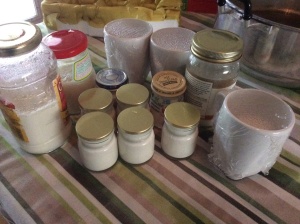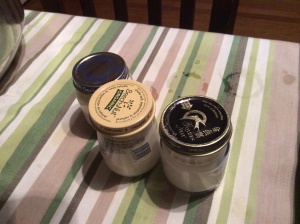 I really enjoyed running experiments while I was in school and working as a researcher. Heck, I aced through all of my science cores. I got to use my skill for something. I also like to eat yogurt, but the store bought yogurt isn’t as good as homemade. Store bought yogurt is old (think about it, by the time it get to you, it’s probably a month or two old). It’s super sour. The Greek yogurt stent Greek at all, they put chemical to thicken it instead of using the Greek method to condense the yogurt. And the cost is mind bogging $1/cup. Ouchy!
I really enjoyed running experiments while I was in school and working as a researcher. Heck, I aced through all of my science cores. I got to use my skill for something. I also like to eat yogurt, but the store bought yogurt isn’t as good as homemade. Store bought yogurt is old (think about it, by the time it get to you, it’s probably a month or two old). It’s super sour. The Greek yogurt stent Greek at all, they put chemical to thicken it instead of using the Greek method to condense the yogurt. And the cost is mind bogging $1/cup. Ouchy!
So I set out to make my own yogurt. Having family recipe helps! Today, I’m sharing my family recipe with you.
Total prep time: 15 minutes! Fast and painless.
Materials:
1. One organic vanilla yogurt cup. This is the starter culture, the label will tell you which culture you’ll be working with if you are interested to know the name.
2. One gallon of whole milk (doesn’t have to be organic). I like whole milk because it’s 3% fat instead of 2% fat! it’s not much more fat! and if you read the label! the 2% contains the same amount of calories. So why not use whole milk, so the yogurt will be smoother and creamier?!
3. 1 can of condense sweeten milk. You can use the longevity brand or any brand that are on sale. Please read the label making sure it’s from real milk instead of from palm oil and a bunch of stuff added together to look like milk.
4. Save a bunch of glass containers from speghtti sauce, baby food jar, pizza sauce yar, etc. or even glass cup if you choose.
5. A big pot that would fit all of those yar. This is the medium. And a towel, or blanket.
Preparation.
1. Pour the condense milk into a bowl. Then mix the starter yogurt in it. Mix well.
2. Use the condense milk can as a measurement cup. My family use the ratio of 1 cup of condense milk to 4 cups of whole milk. I use 1 to 5 ratio. I don’t like it too sweet.
3. 5 cups of milk in a pot on the stove. Use high heat. Stir it until you can put your fingures in and still feel warm, but not boiling. If you have a thermometer 110-115F. I don’t use a thermometer though. Then mixed the condense milk and starter mixture in the pot of warm milk.
4. Pour the mixtures in your glass containers.
5. Pour hot water (I use water from faucet, it’s probably be about 125-130f) into the pot. The level of water is just below the mouth of your glass container.
6. Cover the pot with a lid, and with the blanket in the outside to keep the medium at warmer temperature for 6-8 hours. I kept mine for 8 hours because It would give me the right amount of sourness.
3 ways to eat/store the yogurt.
1. Freeze it. In Southeast Asia, they freeze the yogurt and eat it like ice cream. You’ll have to try it in a hot and humid summer day to feel how good and satisfying it is.
2. Put in in the fridge to eat it cold.
3. Cooking or making dips with it. A little of basil, a little of cucumber, salt and pepper. That’s your dip right there.
Each batch would last me a whole week. I share with my roommates and co-workers. They all love it. I’d usually save 2 little baby food jars as starter. In case one fail, I’d still have a 2nd chance.
Some health benefit of yogurt.
Osteoporosis Protection
According to the National Osteoporosis Foundation, calcium and vitamin D are essential for reducing the risk of osteoporosis, a bone-weakening disease that often strikes postmenopausal women, leading to fractures. One 8-ounce container of yogurt supplies 415 milligrams of calcium, which is 42 percent of the Daily Value, according to the National Institutes of Health’s Office of Dietary Supplements. A glass of 2 percent milk has only 293 milligrams of calcium, making yogurt a better source than milk. Vitamin D is needed for your body to absorb calcium, and yogurt can also be a good source of this nutrient because some yogurt is fortified with vitamin D. Regularly eating yogurt with calcium and vitamin D may help reduce the risk of osteoporosis.
I don’t eat a whole 8oz though, that’s too much calories, I’d eat 1.5 oz baby food jar yogurt with each meal of I can.
Digestive Health
Yogurt is made by bacterial fermentation of milk, a process that may boost digestive health because it produces the same good bacteria found in the gut. Plus, some yogurt contains additional good bacteria known as probiotics. They may help with digestion and irritable bowel syndrome, as well as diarrhea following treatment with antibiotics, which kill off both good and bad bacteria. It helps with irritable bowel symptoms, abdominal pain and gas, although the benefits may depend on the strain of probiotics.
Immune Support
The extra bacteria, or probiotics, added to yogurt have been shown to enhance immunity, perhaps by producing more infection-fighting white blood cells or antibodies in the gut. A number of human studies have found that Lactobacillus acidophilus, a strain of probiotics commonly added to yogurt, can benefit bacterial vaginosis, an infection of the vagina afflicting many women. Still, it can’t hurt to eat yogurt regularly for its potential immune-boosting and infection-fighting properties.
Lactose intolerant?!
If you shy away from dairy products because you’re lactose intolerant, you may be able to eat yogurt on a regular basis because yogurt is low in lactose.
Yogurt has a lot going for it, offering many reasons to eat this tasty dairy food on a regular basis. Personally, making yogurt give me the feeling of running an experiment in the lab, but the product is yummie and tasty. And it saves me tons of money.
What’s about you? Do you make your own yogurt or have a family recipe you’re willing to share?

Sounds delicious. Thanks for sharing your recipe.